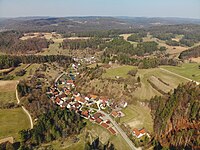Great
|
Great
Hiltpoltstein market
Coordinates: 49 ° 40 ′ 15 ″ N , 11 ° 17 ′ 21 ″ E
|
|
|---|---|
| Height : | 415 m above sea level NHN |
| Residents : | 74 (Jan 2019) |
| Postal code : | 91355 |
| Area code : | 09192 |
|
The Hiltpoltsteiner district of Großenohe
|
|
Großenohe is a Franconian village in the north-western part of the Pegnitz-Kuppenalb .
geography
The village is one of 12 districts of the Hiltpoltstein market in the southwestern part of Upper Franconia . It is located about two and a half kilometers northwest of Hiltpoltstein and is at an altitude of 415 m above sea level. NHN .
history
During the Middle Ages, Großenohe came under the sovereignty of the Bamberg Monastery . The high jurisdiction over the place had it that since the beginning of the 16th century Nürnbergische Pflegamt Hiltpoltstein held that belonging to the Bishopric of Bamberg whereas Bailiwick Office Regensberg fundamental rule over every ten property possessed of the village and the village and community domination exercised. In 1803 the place was handed over to the Prussian Ansbach-Bayreuth in accordance with the conditions agreed in the main state border and purification comparison between the Kingdom of Prussia and Electoral Palatinate Bavaria and thus later became part of the Eschenau street district , a corridor connection that separated the two geographically Parts of this territory were linked by a military road. After the Prussian defeat in the Fourth Coalition War , the village and the entire Principality of Bayreuth were placed under a military administration set up by the French Empire in 1807 . With the acquisition of this principality by the Kingdom of Bavaria in 1810 , Großenohe finally became Bavarian.
As a result of the administrative reforms carried out in the Kingdom of Bavaria at the beginning of the 19th century, Grossenohe became an independent rural community with the second municipal edict in 1818, which also included the two villages of Kappel and Kemmathen as well as the wasteland of Spiesmühle . In 1829 the rural community of Schossaritz, consisting of Schossaritz and Almos , joined this community at its own request, whereupon the enlarged community was named Kappel from now on. In the course of the communal territorial reform carried out in Bavaria in the 1970s , Großenohe was incorporated into the Hiltpoltstein market together with the entire municipality of Kappel in 1978. In 2019 Großenohe had 74 inhabitants.
traffic
The connection to the public road network is established by a communal road that branches off from Bundesstraße 2 between Kemmathen and Kappel and leads north to Großenohe, where it continues after passing through the town in an east-northeast direction to Schossaritz.
Attractions
There are two listed buildings in Großenohe, including one from the 18th and 19th centuries. Century farm.
literature
- Ingomar Bog: Forchheim . In: Historical Atlas of Bavaria . Commission for Bavarian State History, Munich 1955.
- Sigmund Benker, Andreas Kraus (Ed.): History of Franconia up to the end of the 18th century . 3. Edition. Beck, Munich 1997, ISBN 3-406-39451-5 .
Web links
- Bavarian authorities guide , accessed on May 8, 2019
- Großenohe in the BayernAtlas , accessed on May 8, 2019
- Großenohe on historical map , accessed on May 8, 2019
Individual evidence
- ↑ a b Population of Großenohe , accessed on May 8, 2019.
- ^ Grossenohe in the local database of the Bavarian State Library Online . Bayerische Staatsbibliothek, accessed on May 8, 2019.
- ↑ Geographical location of Großenohe in the Bayern Atlas , accessed on May 8, 2019.
- ^ Ingomar Bog: Forchheim . S. 57 .
- ^ Sigmund Benker, Andreas Kraus (ed.): History of Franconia up to the end of the 18th century . 3. Edition. Beck, Munich 1997, ISBN 3-406-39451-5 , p. 523 .
- ^ Hanns Hubert Hofmann: Between power and law. The Eschenau street district between Prussia, the Electoral Palatinate of Bavaria and the imperial city of Nuremberg (1805/1806) . In: Association for the history of the city of Nuremberg eV (Hrsg.): Messages of the association for the history of the city of Nuremberg . tape 53 . Self-published by the Association for the History of the City of Nuremberg, Nuremberg 1965, p. 13–59 ( digital-sammlungen.de [accessed on May 8, 2019]).
- ^ Sigmund Benker, Andreas Kraus (ed.): History of Franconia up to the end of the 18th century . 3. Edition. Beck, Munich 1997, ISBN 3-406-39451-5 , p. 776 .
- ^ Sigmund Benker, Andreas Kraus (ed.): History of Franconia up to the end of the 18th century . 3. Edition. Beck, Munich 1997, ISBN 3-406-39451-5 , p. 529 .
- ^ Sigmund Benker, Andreas Kraus (ed.): History of Franconia up to the end of the 18th century . 3. Edition. Beck, Munich 1997, ISBN 3-406-39451-5 , p. 530 .
- ^ Ingomar Bog: Forchheim . S. 117 .
- ^ Federal Statistical Office (ed.): Historical municipality directory for the Federal Republic of Germany. Name, border and key number changes in municipalities, counties and administrative districts from May 27, 1970 to December 31, 1982 . W. Kohlhammer, Stuttgart / Mainz 1983, ISBN 3-17-003263-1 , p. 684 .


